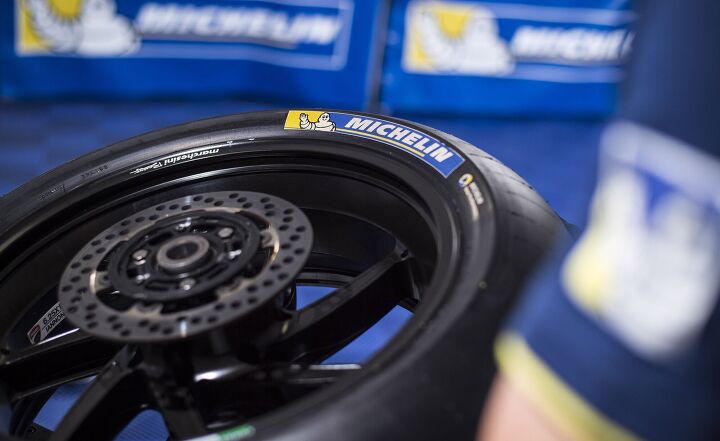Top 10 Facts About Michelin MotoGP Tires

This past weekend at the MotoGP race at the Losail International Circuit in Qatar, I had the opportunity to tour the Michelin paddock area to learn some fascinating information about what happens to the Michelin MotoGP Tires on every race weekend.
In 2016 Michelin took over as the official MotoGP tire supplier after seven seasons of Bridgestone performing that function. The season was a huge learning curve for both Michelin and the riders. Michelin had to come to grips with how far the motorcycles had advanced in the seven years since it last made tires for GP’s premier class, while riders and teams had to grapple with the best way to set up their machinery to get the most out of the Michelin rubber. This adaptation by the riders and their mechanics is best emphasized by the spate of front-end crashes at the start of the season that largely faded by the end of 2016 as Michelin, the riders, and the mechanics worked together to achieve their mutual goal. In MotoGP, the tire manufacturer has to be almost perfect because the safety of the riders depends on it.
10. 1,200 Tires Shipped To Every Race
When I asked the Michelin rep who gave me my tour, I asked for a rough number of tires shipped to every event. The response was there was no rough number but, rather, an exact number. The climate-controlled shipping containers sent to each MotoGP race hold 1,200 tires for use in that weekend. This number includes both slicks and rain tires, so not all of them will be used each weekend.
9. The Tires Have No Price
One of the most asked questions about the MotoGP tires is how much a set costs. The answer is simple: The tires have no price. With Michelin being the sole supplier to MotoGP, the company is at the events to develop winning tires for the best riders in the world and then take the technology developed and transfer it to street rubber. So, the cost is part of the company’s R&D budget. Since the tires are never sold, no cost-per-unit is calculated. Rather the cost per event consists of the tires, the technicians, mounting, balancing, monitoring, and transporting the tires to and from the venue. Additionally, every race has a chemist and an engineer in attendance to gather information. Over the course of a season, the tire tests at various tracks are also a part of the development cost. While the company certainly must track those expenses, no data is publicly available.
8. Michelin Sends 19 Tire Techs To Every Event
These same 19 people travel with the MotoGP series to all of the events around the world for the entire season. In the Michelin area of the paddock, 10 fitters handle all of the tire changes plus the unloading and loading of the tires from the containers. On pit lane, nine technicians are embedded with the teams. These technicians are always with same teams throughout the season and, according to my tour guide, “almost become part of the team.” The technicians’ role within the teams is to advise and aid in tire selection based on their knowledge of the rider’s style and the specific demands of his GP bike. During the weekend, the techs also track tire temperature and check wear to gather data for both Michelin and the rider.
7. Riders Have A Choice Of 22 Tires Per Event
Each rider has a maximum of 10 front and 12 rear tires available over the weekend. Also, the rules specify the maximum number of particular compounds per race weekend. For example, each rider is allowed to select from a maximum of 5 soft, 5 medium, and 5 hard – without going over their 22 tire allocation. Tire selection is made at the beginning of the weekend. However, the rider is given the opportunity to make changes of a maximum of four tires throughout the weekend, if necessary. Since the top two riders in Q2 qualifying end up riding an extra session by making it into Q1, they are allowed one additional set of tires to use for the final determination of the starting grid.
6. Tires Are Tracked From The Moment They Leave Michelin To Their Return From Team
The tires are loaned to the teams and remain the property of Michelin. Each tire has a barcode which is scanned the moment it is pulled from the rack. The tires are also scanned while in the pit box and scanned again when returned – either new or used – to Michelin. According to the Michelin rep, “We know at every moment where every tire is and who’s using it.” If the tires get mixed up, riders could be disqualified. While the tires are with the teams, information is catered about the number of laps, tire temp, tire pressure, times, and other information by the technicians in the pits.
In the photo above, the tire markings show: the cross at top means it is cannot be reused, next is the rider number, and finally the serial number for easy viewing on the tire rack. All tires go back to the Michelin technology center where they are analyzed. Once all of the tires have been looked at, they are destroyed.
5. Michelin Is Using Wheels’ TPS To Track Tires In 2017
Since each wheel’s TPS (tire pressure sensor) has its own unique code and frequency, for 2017 Michelin is experimenting with pairing the tire serial to the TPS. The plan is to scan each rim prior to the start of the race in order to better track which tire compounds each rider has chosen for the race. Sharp-eyed fans can still look for the color coding that is used as a visual means of determining a tire’s compound. For slicks, white denotes soft, while no color is for the medium compound. Yellow marks the hard compound tires.
4. Tire Runout Measured To Less Than 1mm
See the box with the wire coming out of it at the top of the tire balancer? That’s one of five lasers that measures the tire runout (the deviation from center of the tread as the wheel is rotated). The tolerance of less than 1mm assures that the tire is perfectly seated on the rim. Tires that cannot meet this stringent measure are replaced.
3. Tires Are Transported In Climate-Controlled Containers
Because of the volatile nature of chemicals used in these special tires, they travel in climate-controlled containers from the factory to the track. The containers are heated for plane transport to keep them from getting too cold. Ideally, the tires should remain between 50–70° F prior to use.
2. The Rider Has Final Choice On Tire Selection
While the technicians can offer guidance, the rider ultimately makes the call. For an example of when the rider goes against the tech’s recommendation, look to the 2016 race in Austria. Unlike most of the riders, Iannone decided at the last minute to mount a soft front tire, causing much consternation to the technician. At the end of the race, however, Iannone proved himself right by earning Ducati its first MotoGP victory since 2010.
1. New Tire Compounds Can Be Created In Just Three Days
Last year, the changes to tire compounds came fast and furious after Michelin’s hiatus from MotoGP during the Bridgestone spec-tire era, but this isn’t typical. Usually, the compounds are created based on experience from previous races and tests. Since each track is different, requiring different compounds, the tires delivered to events are frequently track-specific. For example, Losail uses an asymmetric compound because of the additional stresses on the right side of the tire since more than half of the turns are right handed. Also, the sand on Losail makes it more abrasive and requiring different compounds than those that would be used at COTA, for example.
Look to Scott Redding’s high-speed tire failure last year in Argentina for an example of how quickly Michelin can respond when necessary. While Michelin couldn’t do anything other than restrict the use of the tires with the potential problem on the race weekend in which the failure occurred, for the track in question, Michelin required the riders use a special tire with a stiffer carcass construction. However, Michelin’s engineers were able to create new tires that addressed this problem and ship them to COTA just a week later thanks to the three-day turnaround.

Like most of the best happenings in his life, Evans stumbled into his motojournalism career. While on his way to a planned life in academia, he applied for a job at a motorcycle magazine, thinking he’d get the opportunity to write some freelance articles. Instead, he was offered a full-time job in which he discovered he could actually get paid to ride other people’s motorcycles – and he’s never looked back. Over the 25 years he’s been in the motorcycle industry, Evans has written two books, 101 Sportbike Performance Projects and How to Modify Your Metric Cruiser, and has ridden just about every production motorcycle manufactured. Evans has a deep love of motorcycles and believes they are a force for good in the world.
More by Evans Brasfield







































Comments
Join the conversation
The article mentions the volatile chemicals used in tires. Did Michelin say what the shelf-life of the tires is? For example, if they manufactured rain tires at the start of the season, but there were no wet races until the end of the season, would they still be good?
Did Michelin mention a "shelf life" for the tires?